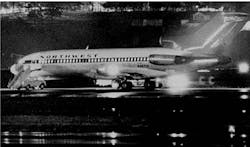Is H&P Part of the Unsolved Mystery of D.B. Cooper?
D.B. Cooper was a man who allegedly hijacked a Boeing 727 in 1971 and parachuted out the aft doorway with $200,000 in cash. The FBI said the man actually used the name Dan Cooper (who knows where the press got D.B. Cooper?) when he paid cash at a Northwest Orient Airlines ticket counter for a one-way flight from Portland, Ore., to Seattle.
Now, for you readers younger than, say, 50, airports weren’t much different from bus stations in the early 1970s. Anyone could enter the concourse, and it wasn’t unusual for panhandlers to hang out at airports hoping to score a little cash. Of course, there was no TSA, bomb-sniffing dogs, and few electronic detectors. And every month the news seemed to report on some “skyjacking” somewhere in the world. Security gradually tightened, so even though it may be hard to believe that a guy could just walk into an airport, buy a ticket without showing identification, and supposedly take a bomb on board, it happened.
Anyway, after the plane was in the air, Cooper passed a note to a flight attendant stating that he had a bomb in his briefcase. He even opened the case to show her he meant business. When the plane landed in Seattle, he let all the other passengers and some of the crew exit the plane in exchange for $200,000 in cash and some parachutes. He eventually ordered the plane to fly to Mexico City at an altitude of about 10,000 ft. At some point during the flight, he removed his necktie, strapped on a parachute and a sack of money, opened the hatch of the rear exit, and jumped out into the darkness.
So what does this have to do with Hydraulics & Pneumatics? Just a few weeks ago I received an email from a guy named Derek, who wrote that his grandfather, James Klansnik, had authored an article in the July 1964 issue of H&P about the hydraulics on the Boeing 727. Furthermore, he believed his grandfather was Dan Cooper. The article even mentions the aft stairway, so Derek really grabbed my attention.
Law enforcement theorized that Cooper would have been familiar with the aft stairway, and he probably knew the minimum altitude and velocity at which the 727 could fly without stalling. So assuming he was in the Portland around that time, it seems plausible that James Klansnik could have been a suspect. (He worked for Boeing, which placed him in the Seattle area.)
Derek said the article contained a picture of Klansnik, and he asked if I had one of better quality. I told him I could scan the image from the printed page, which would be at least a little better than the shot on the website. Derek later confessed, though, that Klansnik was not his grandfather. He just thought I’d be more likely to cooperate if he mentioned a family connection. So I suppose Derek is just one of the dozens of people who thinks he knows who D.B. Cooper was.
The FBI gathered several clues over the years, but nothing definitive. Last year, FBI Special Agent Frank Montoya announced that after nearly 45 years, the FBI was closing the unsolved case. An FBI spokesperson explained, “Unfortunately, none of the well-meaning tips or applications of new investigative technology have yielded the necessary proof. Every time the FBI assesses additional tips ... investigative resources and manpower are diverted from programs that more urgently need attention.”
So unless Derek miraculously digs up conclusive evidence that the FBI couldn’t find after more than 40 years, Dan Cooper will forever remain an unsolved mystery.

